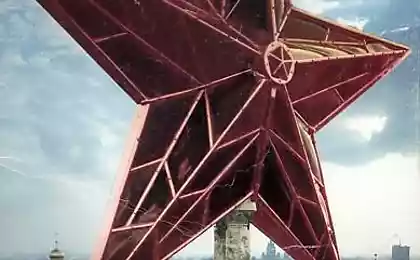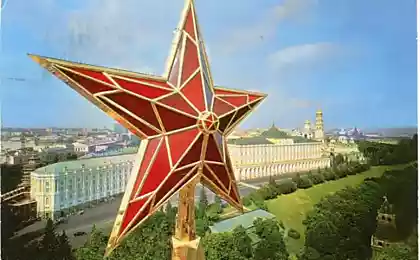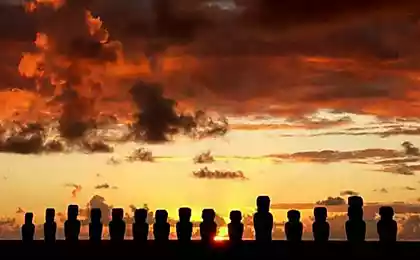323
The mystery of the Christmas star
On Christmas Eve, we look forward to it, the first, brightest star, the prototype of the miraculous phenomenon described by the evangelist Matthew. And the tradition to decorate the top of the Christmas tree with a star began not with the Soviet-style Spassky Tower, but with the same Star of Bethlehem.

I am the root and descendant of David, the bright and morning star. (Rev. 22:16) This phenomenon remains a mystery to astronomers, many hundreds of years about its origin and nature are debated, expressed a variety of hypotheses, natural science and theological. Balaam prophesied about it ("I see him, but not yet; I see him, but not near.") A star rises from Jacob, and a rod rises from Israel (Numbers 24:17) and Isaiah (Rise, shine, Jerusalem, for your light has come, and the glory of the Lord has risen over you). And nations shall come to your light, and kings to the radiance that rises above you. Isaiah 60:1-3. The question of the nature of the Christmas star and the time of its appearance is connected with the determination of the year of the birth of the Savior. (The Roman monk Dionysius the Lesser proposed to keep the account “from the Nativity of Christ” in 525 on the basis of the facts that John began to baptize “in the fifteenth year of the reign of the emperor Tiberius” (Luke 3:1), and he ruled from 14 to 37 AD, and by the time of baptism Jesus Christ was “thirty” (Luke 3:23). However, if we attribute the birth of the Savior to 1 AD, there are contradictions with other Gospel teachings: for Christmas was “in the days of Herod, king of the Jews” (Luke 1:5, Matthew 2:1), and Herod died in 4 BC. Was it a conjunction of planets? For the first time such an idea arose from the Roman theologian Tertullian (II-III centuries). In the XVII century, it is proved by the famous German astronomer Johannes Kepler (1571-1630), in 1604 he observed the convergence of Mars, Saturn and Jupiter, as a result of which a new bright star appeared, the light of which was visible even during the day, calculations showed that at the end of 7 - early 6 BC, Jupiter Saturn was joined three times in the sign of Pisces. One bright star could seem and coincident planets. Interestingly, Jupiter is considered the “royal star”, and Saturn – the Jewish, the fish symbolizes Christ (the name “Christ” in abbreviation is similar to the Greek word “fish”). Therefore, the Magi could interpret the combination of these planets as a sign of the birth of the King of the Jews. Maybe it was a bright new star? This version was adhered to by the martyr Ignatius the God-Bearer (+ early II century), the scientific justification was given by the Italian mathematician and astronomer Geronimo Cardano (1501-1576), according to his calculations, it caught fire in the constellation Cassiopeia, its outbreaks are repeated about once every three hundred years, and one of them was observed at the beginning of our era. In 1977, British scientists D. Clark, J. Parkinson and F. Stephenson analyzed Chinese and Korean astronomical chronicles for the period from 10 BC to 13 BC and compared the Star of Bethlehem with a new star observed for 70 days in 5 BC, flashing near the beta of Capricorn. Could the star of Bethlehem be a comet? For the first time this idea arose from the Greek philosopher and church leader Origen (III century): "She was of the kind of stars," he writes in the work "Against Celsus," which are shown temporarily and are called comets. (...) It is commonly observed that when great events and extraordinary changes occur, such stars appear on the earth.” The scientific substantiation was first expressed in 1907 by the German astronomer A. Stenzel, then it was developed by our scientist A. I. Reznikov in an article of an atheistic nature "Halley's Comet: Demystification of the Christmas legend (1986): "According to ancient Chinese chronicles, in August-October 12 BC, it was possible to observe Halley's comet from the Earth ... in the early days of September the comet entered the constellation of Leo and approached the star Melech, or Regul - the "little king". The constellation of Leo was associated with the names of Judas and his tribe (Gen. 49:9, Rev. 5:5). The image of this constellation was on the banners of the Jews. Therefore, the appearance of a new star in the constellation Leo near Regulus astronomers of that time could be regarded as a sign of the birth of a new King of the Jews.However, all these theories have their drawbacks: It is possible to follow an ordinary star, observing it with the naked eye for as long as you like, because, in fact, it stands still, remaining always far away, it is another thing that in a certain part of the globe it can be better visible, appear brighter, but how could it point to a specific city, moreover, a small cave where the Child lay? Moreover, the gospel star walked as the Magi walked, with their speed, and stopped with them. Experienced astronomers could hardly accept Jupiter and Saturn as one star, especially since, according to modern British scientists, the distance between them was several diameters of the moon, therefore, no special light was visible from the earth. If it was a comet or an unusually bright star, how can one explain why no one noticed it in Jerusalem? In addition, Halley's Comet was visible in 12 BC, and the census of the population indicated in Luke 2:1,2, by decree of Emperor Augustus, was conducted in 6-7 AD during the reign of Quirinius in Syria. In addition, if the Baptism of the Savior is attributed to 29 AD, Jesus Christ would not be about thirty years old, but 42 years old. And finally, should the Magi have made a huge and incredibly dangerous path after the usual celestial phenomenon? “In the hope of what rewards from such a distant side do they go to worship the King? If they thought He would be their King, then there would be no good reason for them to go. If he had been born in the royal palaces, if his father had been a king and was with him, one might say that by worshiping the born child they wanted to please their father, and thereby deserve his favor. But now they know that the newborn will be king not with them, but with another people, in a country far away from them; they know that He is not yet at a perfect age: why do they undertake such a journey, and carry gifts, and are exposed to great dangers in this matter? (...) And what signs did they find of royal rank when they saw a hut, a nursery, a baby in veils, and a poor mother? Who got the gifts? And for what? Was it ordained and customary to pay such homage to every born king? Did they go around the whole universe and about whom did they know that he would become a king from a low and poor state, did they worship him before ascending to the royal throne? writes St. John Chrysostom (see his Interpretation on St. Matthew the Evangelist, conversations VI-VIII). With his opinion, we will begin a short review of the reflections of the holy fathers and theologians about the mysterious star. According to St. John Chrysostom, the Star of Bethlehem Not an ordinary celestial body, but an invisible intelligent force that took the form of a star: How would a star indicate such a cramped place of the manger and hut, if it did not leave the height, come down, and stand above the very head of the Child? (...) So, what prompted them to leave home and decide to go so far? The star and the divine illumination of their thought, which little by little raised them to perfect knowledge. There was nothing great for the senses ... that you could see openly from here the magicians of any kind, and know that they came not as a simple man, but as God and a benefactor. Blessed Theophilact of Bulgaria (Second. Paul XI – early XII century) directly calls the wonderful star “divine and angelic power”. St. Basil the Great in the Word on the Nativity of Christ says: None of the already existing stars could denote this royal Christmas. It was an unusual star. Indeed, those who were created in the first place are either completely stationary or constantly moving. And this one seems to have both these features at the same time. (...) One cannot agree with those who study the circumstances of Christmas with excessive curiosity and claim that this star was like comets, which, as is commonly believed, appear in the sky just to indicate the change of kings. For they are for the most part immovable, representing the ignition, enclosed in a certain place, but that star disappeared from view in Jerusalem, and on the way to Bethlehem again caught fire, “she obeyed someone, served someone and appeared for someone,” says St. Paul. Vasily. Could the ordinary star have been so wise to disappear when the Magi arrived in Jerusalem? As the Monk Ephraim the Syrian explains in the howl of the “Interpretation on the Four Gospels,” “For the embarrassment of Israel, God hid the star from the Magi, so that when they appeared in Jerusalem, the scribes would interpret to them about His birth, and thus they would receive true testimony both from the prophets and from the priests.” St. Ephraim likens her to the Savior: “The star, under whose guidance the Magi made the way, of course, was visible to them, but her body was hidden: in this capacity she was like Christ, whose light shone, of course, to all people, but the ways of the procession were hidden from all people.” Also draws a parallel with the case of Hezekiah (Jewish king, 727-698 B.C.), when in confirmation of healing from a mortal illness, the Lord gave a sign through the prophet Isaiah – the sun went back, and the shadow returned ten degrees (4 Samuel 20:8-11, Isaiah 38:2-8): “There appeared a star, because the prophets ceased.” A star came to show who was the One to whom evils were broadcasting. For as for the sake of Hezekiah the sun went to the east, so for the sake of the Child who was in the manger, the star from the east went to the west. (...) At a joyful birth a joyful star appeared, and at a mournful death a sad darkness appeared. And just as Hezekiah was delivered from visible death by a sign, so the magicians were delivered from hidden death by a sign. Even assuming that the star of Bethlehem was an ordinary celestial body, it could move miraculously, contrary to natural laws, by the will of the Lord, for even through the prayer of Joshua, God stopped the sun and the moon during the battle of the Israelites for Gibeon (Job 10:12-14), “He will say to the sun, and he will not rise, and he will seal the stars” (Job 9:7). A miracle requires not so much rational scientific proof as sincere faith. “Go with the star,” St. Gregory the Theologian calls us, “bring with the Magi gifts – gold, Lebanon, and myrrh – as the King, as God, and as one who died for you.” Glorify with the shepherds, rejoice with the angels, supplication with the archangels, so that the general triumph of the heavenly and earthly Powers will take place. published
Source: www.pravmir.ru/tainstvo-rozhdestvenskoj-zvezdy-2/

I am the root and descendant of David, the bright and morning star. (Rev. 22:16) This phenomenon remains a mystery to astronomers, many hundreds of years about its origin and nature are debated, expressed a variety of hypotheses, natural science and theological. Balaam prophesied about it ("I see him, but not yet; I see him, but not near.") A star rises from Jacob, and a rod rises from Israel (Numbers 24:17) and Isaiah (Rise, shine, Jerusalem, for your light has come, and the glory of the Lord has risen over you). And nations shall come to your light, and kings to the radiance that rises above you. Isaiah 60:1-3. The question of the nature of the Christmas star and the time of its appearance is connected with the determination of the year of the birth of the Savior. (The Roman monk Dionysius the Lesser proposed to keep the account “from the Nativity of Christ” in 525 on the basis of the facts that John began to baptize “in the fifteenth year of the reign of the emperor Tiberius” (Luke 3:1), and he ruled from 14 to 37 AD, and by the time of baptism Jesus Christ was “thirty” (Luke 3:23). However, if we attribute the birth of the Savior to 1 AD, there are contradictions with other Gospel teachings: for Christmas was “in the days of Herod, king of the Jews” (Luke 1:5, Matthew 2:1), and Herod died in 4 BC. Was it a conjunction of planets? For the first time such an idea arose from the Roman theologian Tertullian (II-III centuries). In the XVII century, it is proved by the famous German astronomer Johannes Kepler (1571-1630), in 1604 he observed the convergence of Mars, Saturn and Jupiter, as a result of which a new bright star appeared, the light of which was visible even during the day, calculations showed that at the end of 7 - early 6 BC, Jupiter Saturn was joined three times in the sign of Pisces. One bright star could seem and coincident planets. Interestingly, Jupiter is considered the “royal star”, and Saturn – the Jewish, the fish symbolizes Christ (the name “Christ” in abbreviation is similar to the Greek word “fish”). Therefore, the Magi could interpret the combination of these planets as a sign of the birth of the King of the Jews. Maybe it was a bright new star? This version was adhered to by the martyr Ignatius the God-Bearer (+ early II century), the scientific justification was given by the Italian mathematician and astronomer Geronimo Cardano (1501-1576), according to his calculations, it caught fire in the constellation Cassiopeia, its outbreaks are repeated about once every three hundred years, and one of them was observed at the beginning of our era. In 1977, British scientists D. Clark, J. Parkinson and F. Stephenson analyzed Chinese and Korean astronomical chronicles for the period from 10 BC to 13 BC and compared the Star of Bethlehem with a new star observed for 70 days in 5 BC, flashing near the beta of Capricorn. Could the star of Bethlehem be a comet? For the first time this idea arose from the Greek philosopher and church leader Origen (III century): "She was of the kind of stars," he writes in the work "Against Celsus," which are shown temporarily and are called comets. (...) It is commonly observed that when great events and extraordinary changes occur, such stars appear on the earth.” The scientific substantiation was first expressed in 1907 by the German astronomer A. Stenzel, then it was developed by our scientist A. I. Reznikov in an article of an atheistic nature "Halley's Comet: Demystification of the Christmas legend (1986): "According to ancient Chinese chronicles, in August-October 12 BC, it was possible to observe Halley's comet from the Earth ... in the early days of September the comet entered the constellation of Leo and approached the star Melech, or Regul - the "little king". The constellation of Leo was associated with the names of Judas and his tribe (Gen. 49:9, Rev. 5:5). The image of this constellation was on the banners of the Jews. Therefore, the appearance of a new star in the constellation Leo near Regulus astronomers of that time could be regarded as a sign of the birth of a new King of the Jews.However, all these theories have their drawbacks: It is possible to follow an ordinary star, observing it with the naked eye for as long as you like, because, in fact, it stands still, remaining always far away, it is another thing that in a certain part of the globe it can be better visible, appear brighter, but how could it point to a specific city, moreover, a small cave where the Child lay? Moreover, the gospel star walked as the Magi walked, with their speed, and stopped with them. Experienced astronomers could hardly accept Jupiter and Saturn as one star, especially since, according to modern British scientists, the distance between them was several diameters of the moon, therefore, no special light was visible from the earth. If it was a comet or an unusually bright star, how can one explain why no one noticed it in Jerusalem? In addition, Halley's Comet was visible in 12 BC, and the census of the population indicated in Luke 2:1,2, by decree of Emperor Augustus, was conducted in 6-7 AD during the reign of Quirinius in Syria. In addition, if the Baptism of the Savior is attributed to 29 AD, Jesus Christ would not be about thirty years old, but 42 years old. And finally, should the Magi have made a huge and incredibly dangerous path after the usual celestial phenomenon? “In the hope of what rewards from such a distant side do they go to worship the King? If they thought He would be their King, then there would be no good reason for them to go. If he had been born in the royal palaces, if his father had been a king and was with him, one might say that by worshiping the born child they wanted to please their father, and thereby deserve his favor. But now they know that the newborn will be king not with them, but with another people, in a country far away from them; they know that He is not yet at a perfect age: why do they undertake such a journey, and carry gifts, and are exposed to great dangers in this matter? (...) And what signs did they find of royal rank when they saw a hut, a nursery, a baby in veils, and a poor mother? Who got the gifts? And for what? Was it ordained and customary to pay such homage to every born king? Did they go around the whole universe and about whom did they know that he would become a king from a low and poor state, did they worship him before ascending to the royal throne? writes St. John Chrysostom (see his Interpretation on St. Matthew the Evangelist, conversations VI-VIII). With his opinion, we will begin a short review of the reflections of the holy fathers and theologians about the mysterious star. According to St. John Chrysostom, the Star of Bethlehem Not an ordinary celestial body, but an invisible intelligent force that took the form of a star: How would a star indicate such a cramped place of the manger and hut, if it did not leave the height, come down, and stand above the very head of the Child? (...) So, what prompted them to leave home and decide to go so far? The star and the divine illumination of their thought, which little by little raised them to perfect knowledge. There was nothing great for the senses ... that you could see openly from here the magicians of any kind, and know that they came not as a simple man, but as God and a benefactor. Blessed Theophilact of Bulgaria (Second. Paul XI – early XII century) directly calls the wonderful star “divine and angelic power”. St. Basil the Great in the Word on the Nativity of Christ says: None of the already existing stars could denote this royal Christmas. It was an unusual star. Indeed, those who were created in the first place are either completely stationary or constantly moving. And this one seems to have both these features at the same time. (...) One cannot agree with those who study the circumstances of Christmas with excessive curiosity and claim that this star was like comets, which, as is commonly believed, appear in the sky just to indicate the change of kings. For they are for the most part immovable, representing the ignition, enclosed in a certain place, but that star disappeared from view in Jerusalem, and on the way to Bethlehem again caught fire, “she obeyed someone, served someone and appeared for someone,” says St. Paul. Vasily. Could the ordinary star have been so wise to disappear when the Magi arrived in Jerusalem? As the Monk Ephraim the Syrian explains in the howl of the “Interpretation on the Four Gospels,” “For the embarrassment of Israel, God hid the star from the Magi, so that when they appeared in Jerusalem, the scribes would interpret to them about His birth, and thus they would receive true testimony both from the prophets and from the priests.” St. Ephraim likens her to the Savior: “The star, under whose guidance the Magi made the way, of course, was visible to them, but her body was hidden: in this capacity she was like Christ, whose light shone, of course, to all people, but the ways of the procession were hidden from all people.” Also draws a parallel with the case of Hezekiah (Jewish king, 727-698 B.C.), when in confirmation of healing from a mortal illness, the Lord gave a sign through the prophet Isaiah – the sun went back, and the shadow returned ten degrees (4 Samuel 20:8-11, Isaiah 38:2-8): “There appeared a star, because the prophets ceased.” A star came to show who was the One to whom evils were broadcasting. For as for the sake of Hezekiah the sun went to the east, so for the sake of the Child who was in the manger, the star from the east went to the west. (...) At a joyful birth a joyful star appeared, and at a mournful death a sad darkness appeared. And just as Hezekiah was delivered from visible death by a sign, so the magicians were delivered from hidden death by a sign. Even assuming that the star of Bethlehem was an ordinary celestial body, it could move miraculously, contrary to natural laws, by the will of the Lord, for even through the prayer of Joshua, God stopped the sun and the moon during the battle of the Israelites for Gibeon (Job 10:12-14), “He will say to the sun, and he will not rise, and he will seal the stars” (Job 9:7). A miracle requires not so much rational scientific proof as sincere faith. “Go with the star,” St. Gregory the Theologian calls us, “bring with the Magi gifts – gold, Lebanon, and myrrh – as the King, as God, and as one who died for you.” Glorify with the shepherds, rejoice with the angels, supplication with the archangels, so that the general triumph of the heavenly and earthly Powers will take place. published
Source: www.pravmir.ru/tainstvo-rozhdestvenskoj-zvezdy-2/
Wonderful holiday recipe - potatoes in the oven in French
5 kinds of human diseases from the point of view of Ayurveda























